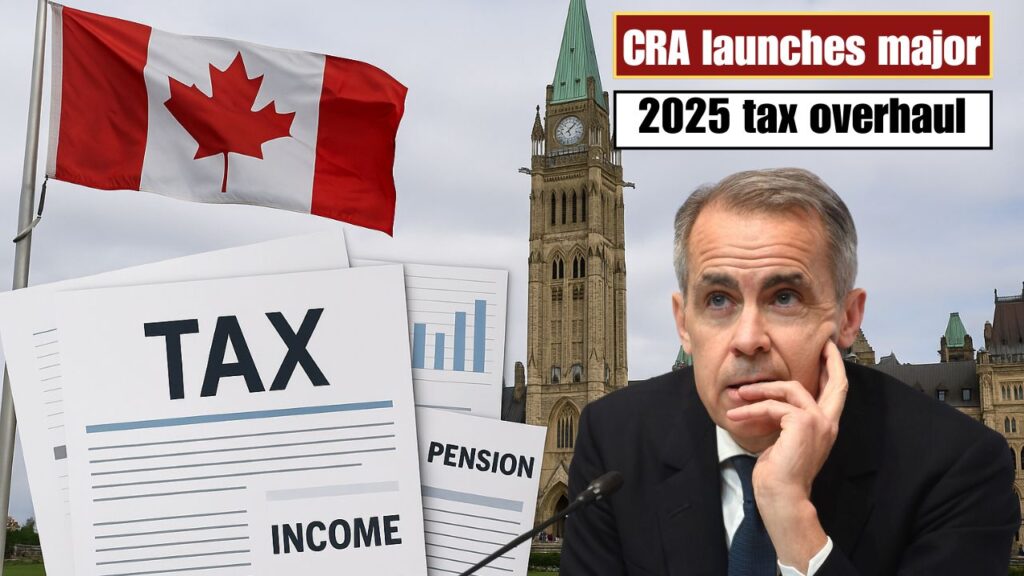Canada Tax System 2025 – The Canada Revenue Agency (CRA) has announced a major overhaul of the Canada Tax System set to begin in 2025, bringing significant changes that will impact every working Canadian and pensioner. The reform aims to modernize tax brackets, streamline deductions, and introduce digital tools for better compliance and transparency. These rule changes are part of the government’s broader plan to address income inequality and inflation-related pressures. Workers and retirees alike must stay informed, as new eligibility thresholds and reporting mechanisms could alter refund amounts and liabilities. Here’s a full breakdown of how the CRA’s 2025 tax system changes will affect you.

CRA 2025 Income Tax Bracket Changes for Workers
One of the most impactful updates in the CRA’s 2025 tax reform is the restructuring of income tax brackets for employed individuals. The federal government has introduced a more progressive structure, increasing the basic personal amount to $17,500 and adjusting marginal tax rates to benefit lower- and middle-income earners. These changes aim to provide relief to full-time workers hit hardest by recent economic shifts. Employers will also be required to update payroll software in line with the new withholding requirements by January 2025. The CRA encourages all workers to review their pay stubs early next year to confirm deductions are accurate under the new regime.
Pensioner Tax Relief and Deductions Under New CRA Rules
For pensioners, the Canada Tax System 2025 introduces expanded non-refundable tax credits and a simplified method for claiming pension income. The Age Amount threshold has increased, while the Pension Income Credit has been revised to allow for more flexibility in how income sources are reported. Additionally, the CRA has made adjustments to RRSP withdrawal tax rates and introduced new digital pre-filing tools for seniors with limited mobility. These changes will help reduce tax filing errors and enhance accessibility. Pensioners are advised to consult with their tax advisors ahead of the 2025 season to ensure they maximize their benefits.
Digital Tax Filing Innovations and Compliance Adjustments
The CRA is also investing in digital tools to streamline tax compliance. Beginning in 2025, all taxpayers will be required to use the updated “Auto-Fill My Return” feature if filing online, as the system integrates directly with employers, pension providers, and financial institutions. This is expected to reduce audit risks and improve refund accuracy. Moreover, the agency will implement stricter penalties for late filers and incorrect submissions under the new CRA compliance code. Canadians should ensure their MyCRA accounts are up to date and that they have verified their banking and personal details ahead of the filing window.
New CRA Thresholds and Refund Expectations for 2025
In addition to structural changes, the CRA has updated the thresholds for several tax credits, including the Canada Workers Benefit and Disability Tax Credit. As a result, more low-income families and persons with disabilities may see larger refunds or reduced tax liabilities. Refund timelines are also expected to speed up for digital filers using direct deposit. The CRA is targeting a 7–10 business day refund turnaround for most eligible taxpayers. However, those claiming complex deductions may still experience processing delays. Being proactive and accurate with your tax return in early 2025 will ensure you benefit from the system’s enhancements.
FAQs
Q1: When will the new CRA tax rules start?
January 1, 2025.
Q2: Will pensioners need to reapply for benefits under the new system?
No, benefits are adjusted automatically based on filings.
Q3: Are refunds expected to be faster in 2025?
Yes, direct deposit filers may receive refunds within 10 days.
Q4: What happens if I don’t update my tax profile?
You may face delays or penalties during the filing process.




